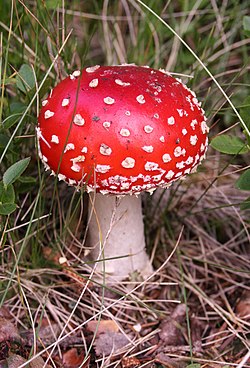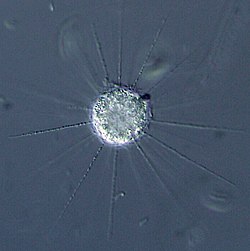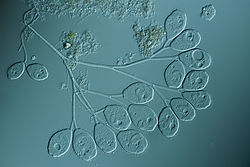Giardia lamblia SEM 8698 lores
Formát:
626 x 737 Pixel (27282 Bytes)
Popis:
This scanning electron micrograph (SEM) revealed some of the external ultrastructural details displayed by a flagellated Giardia lamblia protozoan parasite. G. lamblia is the organism responsible for causing the diarrheal disease "giardiasis". Once an animal or person has been infected with this protozoan, the parasite lives in the intestine, and is passed in the stool. Because the parasite is protected by an outer shell, it can survive outside the body, and in the environment for long periods of time.
Cysts are resistant forms and are responsible for transmission of giardiasis. Both cysts and trophozoites can be found in the feces (diagnostic stages). The cysts are hardy and can survive several months in cold water. Infection occurs by the ingestion of cysts in contaminated water, food, or by the fecal-oral route (hands or fomites). In the small intestine, excystation releases trophozoites (each cyst produces two trophozoites). Trophozoites multiply by longitudinal binary fission, remaining in the lumen of the proximal small bowel where they can be free or attached to the mucosa by a ventral sucking disk. Encystation occurs as the parasites transit toward the colon. The cyst is the stage found most commonly in non-diarrheal feces. Because the cysts are infectious when passed in the stool or shortly afterward, person-to-person transmission is possible. While animals are infected with Giardia, their importance as a reservoir is unclear.
Komentář k Licence:
Copyright Restrictions: None - This image is in the public domain and thus free of any copyright restrictions. As a matter of courtesy we request that the content provider be credited and notified in any public or private usage of this image.
Více informací o licenci na obrázek naleznete zde. Poslední aktualizace: Tue, 15 Apr 2025 09:58:15 GMT
Relevantní obrázky
Relevantní články
Lamblie střevní
Lamblie střevní je parazitický prvok z řádu diplomonád. V širším pojetí se jedná o několik druhů, které lze od sebe odlišit na základě charakteristických morfologických znaků u trofozoitů. Onemocnění způsobené lambliemi se označuje jako giardióza či lamblióza.
.. pokračovat ve čtení
Klasifikace eukaryot
Klasifikace eukaryot od přibližně 90. let 20. století prošla výraznou změnou a dosud není plně stabilní. Stále ve větší míře se prosazuje fylogenetický přístup, tedy snaha respektovat v klasifikačních systémech skutečnou příbuznost jednotlivých skupin, nikoliv pouze podobné znaky. Různé aktuální studie používají vzájemně odlišné klasifikační systémy, jen málokteré z nich si kladou za cíl pokrýt celkový rozsah eukaryotní domény. Níže uvedené systémy proto nejsou závazné, ale jsou uvedeny jako příklady dvou možných, ale přitom šířeji aplikovaných v mezinárodních projektech. Oba jsou zaměřeny zejména na jednobuněčná eukaryota (protista) a systémy pro klasické mnohobuněčné říše ponechávají na specializovaných projektech ; podobně i na wikipedii se jimi zabývají samostatné články Klasifikace rostlin, Klasifikace hub a Klasifikace živočichů.
.. pokračovat ve čtení













